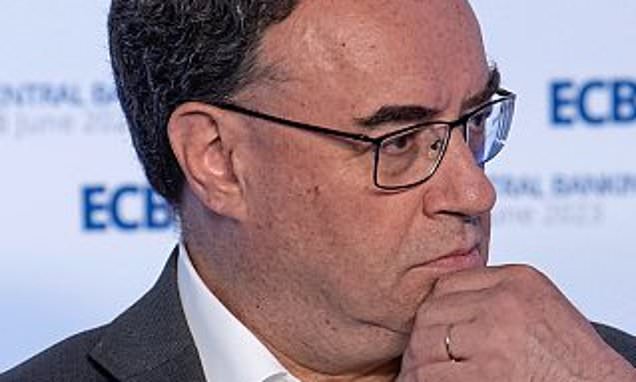
Bank of England boss Andrew Bailey signals interest rate pain to come as he insists that it will not depart from its target of cutting inflation to 2%

- Bailey said it was ‘absolutely critical’ there should be no confusion about target
- Bank is struggling to get near it with inflation currently at 8.7 per cent
- Comments likely to reinforce expectations over aggressive series of hikes
Bank of England governor Andrew Bailey has signalled more interest rate pain to come as he insisted that it will not depart from its target of cutting inflation to 2 per cent.
Bailey said it was ‘absolutely critical’ that there should be no confusion about the target even as the Bank struggles to get near it with inflation currently at 8.7 per cent.
The comments are likely to reinforce market expectations that rate-setters will continue an aggressive series of hikes even if they threaten to drag the economy into recession.
The Bank has increased rates from 0.1 per cent in December 2021 to 5 per cent today and traders are betting they will hit 6.5 per cent in the coming months.
That is causing a painful squeeze on mortgage borrowers who are seeing hundreds of pounds added to their monthly repayments. A determination to take inflation all the way down to 2 per cent is likely to add to that pain.
Bailey’s remarks came during a conference in France – where he acknowledged that the UK was facing a ‘more severe’ inflation problem than other countries – where it has fallen more quickly.
Related Articles
HOW THIS IS MONEY CAN HELP
He said the Bank had some leeway on the timing of bringing inflation down to 2 per cent but added: ‘It is absolutely critical that that flexibility isn’t confused with people thinking we are not pursuing 2 per cent any more.’ The comments come amid calls in some quarters for the 2 per cent level – which is targeted by most central banks – to be altered.
Supporters of the change say that by raising the target, for example to 3 per cent or even 4 per cent, rare-setters could give themselves more flexibility and spare some of the pain that could result by sticking to the lower level.
But Bailey defended the 2 per cent target, saying it was low enough that consumers do not have to worry constantly about prices going up when making everyday economic decisions.
Some links in this article may be affiliate links. If you click on them we may earn a small commission. That helps us fund This Is Money, and keep it free to use. We do not write articles to promote products. We do not allow any commercial relationship to affect our editorial independence.





